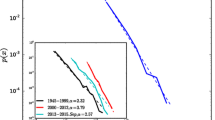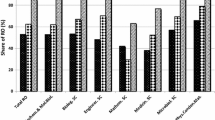Abstract
In this study, we analyze the dynamic usage history of Nature publications over time using Nature metrics data. We conduct analysis from two perspectives. On the one hand, we examine how long it takes before the articles’ downloads reach 50 %/80 % of the total; on the other hand, we compare the percentage of total downloads in 7, 30, and 100 days after publication. In general, papers are downloaded most frequently within a short time period right after their publication. And we find that compared with non-Open Access papers, readers’ attention on Open Access publications are more enduring. Based on the usage data of a newly published paper, regression analysis could predict the future expected total usage counts.





Similar content being viewed by others
References
Bollen, J., & Luce, R. (2002). Evaluation of digital library impact and user communities by analysis of usage patterns. D-Lib Magazine, 8(6), 1–13.
Brody, T., Harnad, S., & Carr, L. (2006). Earlier web usage statistics as predictors of later citation impact. Journal of the American Society for Information Science and Technology, 57(8), 1060–1072.
Davis, P. M., Lewenstein, B. V., Simon, D. H., Booth, J. G., & Connolly, M. J. L. (2008). Open access publishing, article downloads, and citations: randomised controlled trial. BMJ, 337, a56.
Davis, P. M., & Price, J. S. (2006). eJournal interface can influence usage statistics: implications for libraries, publishers, and Project COUNTER. Journal of the American Society for Information Science and Technology, 57(9), 1243–1248.
Davis, P. M., & Solla, L. R. (2003). An IP-level analysis of usage statistics for electronic journals in chemistry: Making inferences about user behavior. Journal of the American Society for Information Science and Technology, 54(11), 1062–1068.
Galligan, F., & Dyas-Correia, S. (2013). Altmetrics: Rethinking the Way We measure. Serials Review, 39(1), 56–61.
Henneken, E. A., Eichhorn, G., Accomazzi, A., Kurtz, M. J., Grant, C., Thompson, D., et al. (2010). How the literature is used a view through citation and usage statistics of the ADS. In Proceedings of the Third UN/ESA/NASA Workshop on the International Heliophysical Year 2007 and Basic Space Science (pp. 141–147). Berlin, Springer.
Henneken, E. A., Kurtz, M. J., Accomazzi, A., Grant, C. S., Thompson, D., Bohlen, E., et al. (2009). Use of astronomical literature—A report on usage patterns. Journal of Informetrics, 3(1), 1–8.
ImpactStory. (2012). A new framework for altmetrics. http://blog.impactstory.org/2012/09/14/31524247207/2013. Accessed 29 Oct 2013.
Kaplan, N. R., & Nelson, M. L. (2000). Determining the publication impact of a digital library. Journal of the American society for information science, 51(4), 324–339.
Kousha, K., Thelwall, M., & Rezaie, S. (2010). Using the web for research evaluation: the integrated online impact indicator. Journal of Informetrics, 4(1), 124–135.
Kurtz, M. J., Eichhorn, G., Accomazzi, A., Grant, C., Demleitner, M., & Murray, S. S. (2005a). Worldwide use and impact of the NASA Astrophysics Data System digital library. Journal of the American Society for Information Science and Technology, 56(1), 36–45.
Kurtz, M. J., Eichhorn, G., Accomazzi, A., Grant, C., Demleitner, M., Murray, S. S., et al. (2005b). The bibliometric properties of article readership information. Journal of the American Society for Information Science and Technology, 56(2), 111–128.
Lin, J., & Fenner, M. (2013). Altmetrics in Eeolution: Defining & redefining the ontology of article-level metrics. Information Standards Quarterly, 25(2), 20.
Marek, K., & Valauskas, E. J. (2002). Web logs as indices of electronic journal use: Tools for identifying a “classic” article. Libri, 52(4), 220–230.
Nature. (2012). Nature metrics. Nature, 491(7422), 8. doi:10.1038/491008b.
Priem, J., & Hemminger, B. H. (2010). Scientometrics 2.0: New metrics of scholarly impact on the social Web. First Monday, 15(7). doi:10.5210/fm.v15i7.2874.
Priem, J., Taraborelli, D., Groth, P., & Neylon, C. (2010). Altmetrics: A manifesto. http://altmetrics.org/manifesto/. Accessed 29 Oct 2013.
Shuai, X., Pepe, A., & Bollen, J. (2012). How the scientific community reacts to newly submitted preprints: article downloads, Twitter mentions, and citations. arXiv preprint arXiv:1202.2461.
Thelwall, M. (2008). Bibliometrics to webometrics. Journal of information science, 34(4), 605–621.
Thelwall, M. (2012). Journal impact evaluation: A webometric perspective. Scientometrics, 92(2), 429–441.
Wang, X., Peng, L., Zhang, C., Xu, S., Wang, Z., Wang, C., et al. (2013). Exploring scientists’ working timetable: A global survey. Journal of Informetrics, 7(3), 665–675.
Wang, X., Wang, Z., & Xu, S. (2012a). Tracing scientist’s research trends realtimely. Scientometrics, 95(2), 717–729.
Wang, X., Xu, S., Peng, L., Wang, Z., Wang, C., Zhang, C., et al. (2012b). Exploring scientists’ working timetable: Do scientists often work overtime? Journal of Informetrics, 6(4), 655–660.
Wei, J., Bu, B., & Liang, L. (2012). Estimating the diffusion models of crisis information in micro blog. Journal of Informetrics, 6(4), 600–610.
Acknowledgments
The work was supported by the project of “National Natural Science Foundation of China” (61301227), “Social Science Foundation of China” (10CZX011) and the project of “Fundamental Research Funds for the Central Universities” (DUT12RW309).
Author information
Authors and Affiliations
Corresponding author
Additional information
Wenli Mao and Shenmeng Xu contributed equally as second authors.
Rights and permissions
About this article
Cite this article
Wang, X., Mao, W., Xu, S. et al. Usage history of scientific literature: Nature metrics and metrics of Nature publications. Scientometrics 98, 1923–1933 (2014). https://doi.org/10.1007/s11192-013-1167-5
Received:
Published:
Issue Date:
DOI: https://doi.org/10.1007/s11192-013-1167-5




